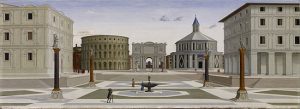Unità 1 – Una giornata in Italia
Learning Objectives – Unità 1 – Una giornata in Italia
Welcome to the first unit Giornate Italiane and of the Italian beginners course.
In this unit you will learn to introduce yourself and others in formal and informal situations, and to talk about familiar places.
By the end of this unit you will also be able to talk about the geographical elements and cultural aspects of Italian cities, like the piazza.
Remember:
In this course we value self-expression and creativity: you are not required to share personal information unless you are comfortable with doing so.
You are welcome to make up information as long as you practice and use the Italian language.
1.1 Introduzione
Benvenuti nel corso di italiano principianti!
Study the vocabulary "I Saluti" and the grammar "L’alfabeto italiano" then do the exercises embedded in this book. You can do these exercises at your own pace and as extra practice while you study. All the exercises embedded in Giornate Italiane are not graded.
1.2 Conosciamoci!
In classe
Vocabolario: I Saluti
Grammatica: L’alfabeto

Attività 1 – I Saluti
Step 1: Watch the video "How to greet in Italian – I saluti" by Easy Italian – Youtube. While you watch the video with the whole class, students should orally repeat the greetings.
Step2: Answer the following questions
- How do you say “hello” in formal and informal situations in Italian?
- What does “Come stai?” mean?
Step 3: Match the English with the Italian translation. Then determine whether they are formal or informal sentences.
| Buongiorno | How are you? |
| Come sta? | Good morning |
| Piacere di conoscerLa | Hi / goodbye |
| Salve! | Nice to meet you. |
Attività 2 – L’alfabeto
Step 1. Click L’alfabeto italiano for the following activity. Match the nouns with the images and then put them in alphabetical order.
Step 2. Then work in pairs, pick 6 words and ask the following:
- Come si dice “water” in italiano?
- Si dice “acqua”
- Come si scrive “acqua” in italiano?
- A-C-Q-U-A
Step 3. Guess the famous person.
Work in pairs and think about the name of two famous people then spell them following the example below. The other student has to guess. Be ready to do it again in front of the class.
- il nome si scrive: R-O-B-E-R-T-O
- Il cognome si scrive: B-E-N-I-G-N-I
Attività 3 – Presentiamoci
Walk around the room and introduce yourself to your classmates. Use all the expressions you’ve learned so far.
1.3 Come sta?
A casa
Study the vocabulary "Espressioni per presentarsi" and the grammar "Essere / Stare / Avere" then do the exercises embedded in this book. You can do these exercises at your own pace and as extra practice while you study. All the exercises embedded in Giornate Italiane are not graded.
1.4 Presentiamo altre persone
In classe
Vocabulary “Espressioni per presentarsi”
Grammar “Essere / Stare”
Attività 1 – Revisione pronomi soggetto e coniugazione Essere / Stare
- Decide if the scenarios in the video are formal or informal and explain why.
| Formale | Informale | |
| Scenario 1 | ||
| Scenario 2 | ||
| Scenario 3 |
2. What does “Di dove sei?” mean? How would you reply?
3. How do you reply to the question “Come stai? / Come sta?”?
4. What words can you use to introduce another person?
5. How do you say “Where are you from”?
Step 2 – Work in pairs, pick one of the following images and then answer the following questions.
- Do you think it is a formal or informal situation?
- Which expressions would you use to greet people?
- Which expressions would you use to introduce other people?
 |
 |
Step 3 – Work in groups of three students. Pretend to be in Italy, and introduce your friend who just arrived in Rome to your classmates and to your professor.
Decide how to address the people in the various situations, use all the structures studied so far "greetings" "how are you?" "where are you from" "how do you spell your name" etc.
Step 4 – Play your dialogue in front of the class.
1.5 – Una presentazione virtuale
A casa
Parliamo 1
Una presentazione virtuale
Go to Canvas and complete Parliamo#1
Record a video message while you read and answer the following questions with complete sentences in Italian.
Then, in English, tell us why you decided to study Italian.
1) Come ti chiami?
2) Come si scrive il tuo nome?
3) Come stai?
3) Di dove sei?
4) Quanti anni hai?
1.6 – Benvenuti in Italia
A casa
Study the vocabulary "La geografia" and the grammar "Il sostantivo singolare" and "Essere / Stare / Avere" then do the exercises embedded in this book. You can do these exercises at your own pace and as extra practice while you study. All the exercises embedded in Giornate Italiane are not graded.
1.7 – Io scelgo la regione
In classe
Vocabolario: “La geografia“
Grammatica: “Il sostantivo singolare”
Review week 1
Use the following "Review Week 1" to complete the activity
Riflettiamo: Essere o Stare
-
Work in pairs and complete the conjugation of the verbs.
2. Complete the sentences with the correct form of the verb Essere or Stare and explain the reason of you choice.
Attività 1 – Revisione del vocabolario
Go to Google Maps (IT) to find the following geographical elements then complete their names with the correct noun among the given ones.
Attività 2 – Io scelgo l’Italia
Step 1-
Watch the video “Spot della nazionale di Calcio – Io scelgo l’Italia.” and put a checkmark next to the words you hear or see in the video.
PLEASE USE THE FOLLOWING DOCUMENT THE COMPLETE THE ACTIVITY
Sardegna |
Firenze |
Piemonte |
collina |
Lombardia |
stazione |
mare |
fiume |
lago |
monumento |
città |
Michelangelo |
Venezia |
turista (tourist) |
paese |
gondola |
Sicilia |
professore |
Step 2– Put the words in the chart above into the appropriate column.
| Nomi di regioni (region’s names) | Nomi di città (cities’ names) | Elementi geografici (geographical elements) | altro (other) |
Step 3 – Divide the words in the chart above into masculine and feminine.
| Maschile | Femminile |
Riflettiamo! Il sostantivo singolare
Step 3 – Scegli la regione: Work with a partner. Each student should pick a region and watch the video for a couple of minutes. Then each student gives at least three reasons why he/she picks that region. (Keep it easy and use the following example as a suggestion).
Example: Io scelgo la Lombardia perché c’è un lago etc..
Step 4 – Read your sentences to the class.
Extension of the activity: Ask the students to tell what’s in their State of origin and the other students’ can guess.
Lettura Culturale
Reading tips:
Alternate turns reading the text aloud in your group, focusing on words that you studied and that you already know. You will notice that some words are very similar to English in their form and their meaning.
Try to get the general meaning of each sentence, don’t worry about knowing every single word!
L’Italia è una penisola ed è in Europa. L’Italia ha una forma di stivale e gli italiani la chiamano “Lo Stivale” oppure "il Bel Paese". Roma è la capitale d’Italia. Roma è una grande città nella regione Lazio. Il Lazio è una regione del centro Italia.
In Italia ci sono 20 (venti) regioni, ci sono 2 (due) isole maggiori : la Sicilia e la Sardegna e tante isole minori. Ogni regione ha una città capoluogo ad esempio: Firenze è il capoluogo della Toscana, Milano è il capoluogo della Lombardia e Napoli è il capoluogo della Campania.
In Italia ci sono due catene montuose molto importanti: Le Alpi (da ovest a est) e gli Appennini (da nord a sud). Nelle Alpi c’è il Monte Bianco che è la montagna più alta d’Europa.
In Italia ci sono 5 (cinque) mari: Mar Ligure, Mar Tirreno, Mar Ionio, Mar Adriatico e Mar Mediterraneo.
In Italia ci sono molti laghi, il più grande è il Lago di Garda, ma altri laghi famosi sono il lago di Como, il lago di Lecco e il Lago Maggiore.
Ci sono anche tanti fiumi, un fiume famoso è il fiume Tevere che attraversa Roma. Il fiume Po al nord Italia e il fiume Arno che attraversa Firenze.
Sul territorio italiano ci sono anche 2 (due) vulcani attivi: Etna e Stromboli ed altri vulcani a riposo come il Vesuvio a Napoli.
Sul territorio italiano ci sono due stati indipendenti: Città del Vaticano e la Repubblica di San Marino.
Esercizio 1 : Review the following words and try to understand their translation from the context.
- Esempio
- Europa
- Penisola
- Regione
- Stati indipendenti
- Capitale
Esercizio 2: Answer the following questions in your group
- La capitale dell’Italia è Trieste. V – F
- Il Po è un lago. V – F
- In Italia ci sono 5 mari. V – F
- La Repubblica dei San Marino è una regione italiana. V – F
1.8 – Il centro della città
A casa
Study the vocabulary La piazza e la città and the grammar L’ articolo indeterminativo then do the exercises embedded in this book at your own pace while you study.
Leggiamo 1
Il centro della città
Go to Canvas and complete Leggiamo#1

In Italia ci sono molte grandi città ma ci sono anche tante piccole città e piccoli paesi. Le città più grandi in Italia sono Napoli, Milano e Roma, ma in Italia ci sono tante altre belle città e ogni città è unica.
In ogni città italiana, anche in quella più piccola, c’è almeno una piazza.
La piazza italiana è uno spazio publico aperto ed è nel centro della città. La piazza è spesso circondata da molti edifici, palazzi storici e negozi.
In una piazza c’è una chiesa, c’è una banca, c’è una fontana, c’è un monumento, c’è un’aiuola e c’è un albergo. Ci sono i negozi, i bar, i ristoranti e i turisti.
In Italia le città hanno forme diverse. Ci sono città medioevali, città fortezza, città a forma di stella e città molto moderne. Anche le piazze italiane hanno diverse forme. Ci sono piazze con tre lati, piazze che hanno una una scacchiera o piazza a forma di conchiglia.
- Read the following questions and be ready to answer them in class. Decide whether each statement is vero (V) or falso (F). Correct all the answers that are false.
- Le città più grandi in Italia sono: Milano, Orvieto e Cagliari. V – F
- La piazza ha solo forma quadrata. V – F
- La piazza è uno spazio pubblico aperto nel centro della città. V – F
- In piazza c’è una banca, una fontana e uno stadio. V -F
1.9 Un incontro in piazza
In classe
Vocabolario: La piazza
Grammatica: l’articolo indeterminativo
Revisione Essere e Stare al plurale
Attività 1 – Revisione
Do you know the squares in the pictures below? Match the images with their names.
Now watch the video Piazze d’Italia and discuss the following questions (in English) with your classmates.
- Did you recognize in the video the squares in the images above?
- Do you recognize other cities or squares in the video?
- What do people do while they are in the squares?
Riflettiamo! Indefinite articles
Match the words with their articles and then discuss their use by completing the rule
Attività 2 – Incontriamoci in piazza
Situation: You are in Italy and want to invite a friend to a famous piazza, but you forget the name so need to describe it to them instead of naming it.
Step 1 – Work in groups of three and visit "Le 10 piazze salotto più belle d’Italia."
Pick ONE picture from the gallery and say as many words aloud as you remember to describe what’s in the piazza. See how many your group can name in the 2 minutes on the timer.
Step 2 – Pick one of the pictures and describe the square where you want to meet your friend. Your groupmates will guess the square. Repeat until each student has described a piazza.
Step 3 -Describe the square you’d like to meet in.
Step 4 – Perform your dialogue in front of the class.
1.10 – A casa
L’angolo della pronuncia
Study the rule then go to Canvas an complete the assignment: Pronuncia#1
I suoni ci / ce – chi /che/co/ca/cu
When followed by a, o, u or h, the letter C has a hard sound like in the English word car. caldo, corpo, cuore, che.
When followed by e or i, the letter C has a soft sound like in the English word chain. centro, cinema.
I suoni gi / ge – ghi /ghe/go/ga/gu
When followed by a, o, u or h, the letter G has a hard sound like in the English word go.
When followed by e or i the letter G has a soft sound like in the English word gym.
1.11 – Un luogo speciale
A casa
Study the vocabulary "La città" and the grammar "L’articolo determinativo" e "Il plurale" then do the exercises embedded in this book at your own pace while you study.
Ascoltiamo 1
Una piazza sul Lago Maggiore
Go to Canvas and complete Ascoltiamo#1
Watch the video: How to use c’è and ci sono by Super Easy Italian
Answer the comprehension questions on Canvas.
1.12 – La mia città
In classe
Vocabolario “La città”
Grammatica: “L’articolo determinativo” e “Il plurale”
Attività 1 – Revisione
Riflettiamo! – The definite article
Work in pairs. Read the word after each blank and decide which definite article to use. Try to apply the rule as much as you can without looking at your note or the translation of the words. After you tried the first time, use wordreference to check the gender of the nouns that you couldn’t figure out.
Then listen to the song Io Canto (Laura Pausini – 2006) with Italian and English translation and check the corrections.
Review the definite article rule with your instructor.
Now transform the following words into plural and check the rule with your classmates.
- L’ascensore
- La mattina
- Il bambino
- Lo sguardo
Attività 2 – La mia città
Situation: Your Italian friend visits you and you talk about your town.
Objective: Talk about your town and familiar places.

Step 1 – Work in pairs and watch the video Palermo (Sicily) then write down as many words as you remember to describe the city in 1 minute. The student that can remember more words and writes them down with the correct spelling wins the game.
Step 2. Work with the same classmate and think about a city you like (real or not…you can make it up) and fill the chart below with words (articles and nouns) to describe the city.
| Mezzi di trasporto | Edifici o luoghi pubblici | Negozi e ristoranti | Luoghi di Cultura | Geografia |
Step 3 – Now write a few sentences to describe your town and think about questions that you can ask to your friends to describe their town.
Step 4 – Go around the class and talk with the other classmates about your towns.
1.13 – Gioco in città
A casa
Study the vocabulary "I numeri 0-20" and review the grammar "c’è / ci sono" then do the exercises embedded in this book at your own pace while you study.
You can practice the numbers and the use of c’è/ ci sono with the following game: Un giro in città
1.14 – La mia città americana preferita
In classe
Scriviamo 1
Luoghi di ritrovo
Write a short composition of 30-40 words in Italian on the following topic.
- Describe a gathering place in an American city or an American city of your choice.
While you write your production, make sure to use the grammar structures and vocabulary studied in this unit.
Hai finito l’unità 1, vai su Canvas e completa la Review Unit 1
You completed Unit 1. Go to Canvas and complete your Review Unit 1
shape
boot
the beautiful country
center
major / big
minor / small
mountain chains
that is
that goes through
chess board
shell shaped

